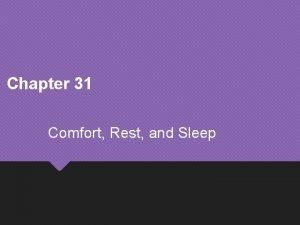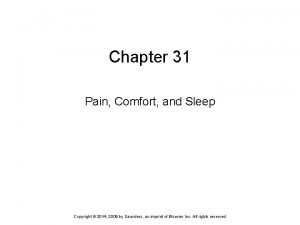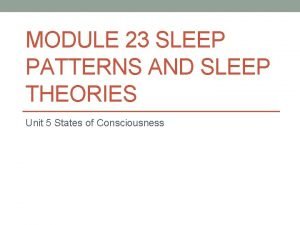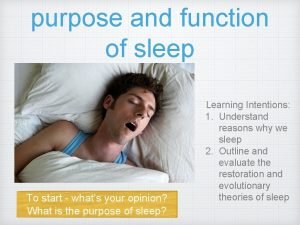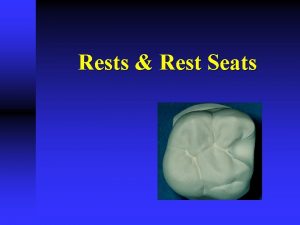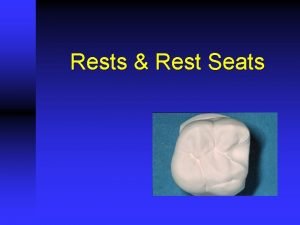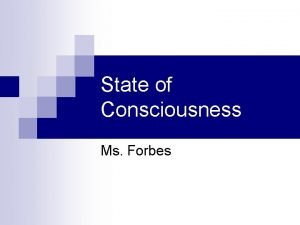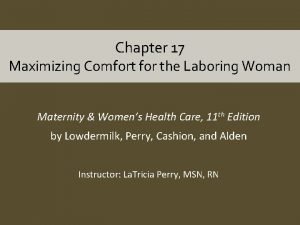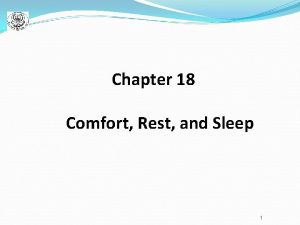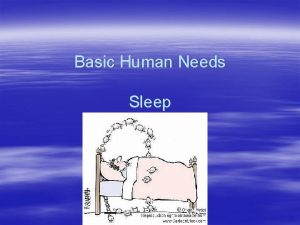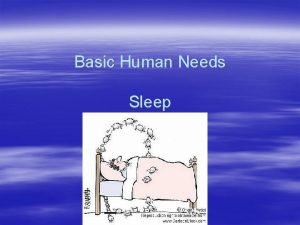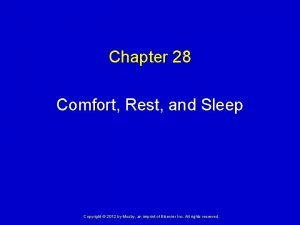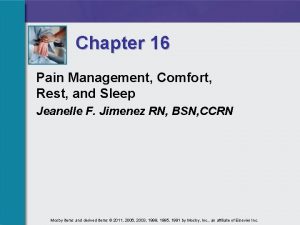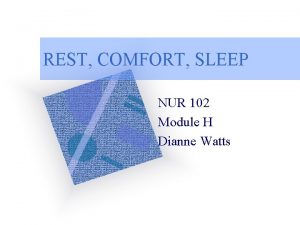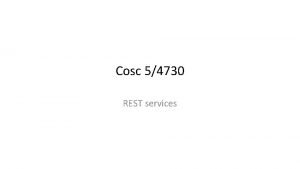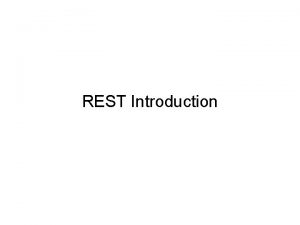Chapter 31 Comfort Rest and Sleep Copyright 2017




















- Slides: 20

Chapter 31 Comfort, Rest, and Sleep Copyright © 2017, Elsevier, Inc. All rights reserved.

Comfort, Rest, and Sleep Comfort, rest, and sleep are needed for wellbeing. Comfort, rest, and sleep problems affect the total person. Ø Physical, emotional, spiritual Discomfort and pain: Can be physical or emotional Ø Affect rest and sleep Ø Decrease function and quality of life Ø Rest and sleep restore energy and well-being. Copyright © 2017, Elsevier, Inc. All rights reserved. 2

Comfort is a state of well-being. The person has no physical or emotional pain. Ø He or she is calm and at peace. Ø Comfort is affected by: Ø Ø Ø Ø Age Illness Activity Temperature Ventilation Noise Odors Lighting Copyright © 2017, Elsevier, Inc. All rights reserved. 3

Pain or discomfort means to ache, hurt, or be sore. Comfort and discomfort are subjective. You must rely on what the person says. Ø If a person complains of pain or discomfort, the person has pain or discomfort. Ø Pain is personal. Ø It differs for each person. Pain is a warning from the body. It is often called the fifth vital sign. Ø It signals tissue damage. Ø Copyright © 2017, Elsevier, Inc. All rights reserved. 4

Pain (Cont. ) Types of pain Acute pain is felt suddenly from injury, disease, trauma, or surgery. Ø Chronic pain (persistent pain) continues for a long time (months or years) or occurs off and on. Ø Radiating pain is felt at the site of tissue damage and in nearby areas. Ø Phantom pain is felt in a body part that is no longer there. Ø Copyright © 2017, Elsevier, Inc. All rights reserved. 5

Pain (Cont. ) Factors affecting pain Ø Past experience • Knowing what to expect can help or hinder how the person handles pain. Anxiety • Pain cause anxiety. • Anxiety increases how much pain is felt. • Reducing anxiety helps lessen pain. Ø Rest and sleep • Rest and sleep restore energy. • Pain seems worse when tired or restless. Ø Copyright © 2017, Elsevier, Inc. All rights reserved. 6

Pain (Cont. ) Ø Attention • The more a person thinks about the pain, the worse it seems. Personal and family duties • Pain is often ignored when there are children to care for. Ø The value or meaning of pain • To some people, pain is a sign of weakness. • To others, pain is used to avoid certain people or things Ø —the pain is useful. Copyright © 2017, Elsevier, Inc. All rights reserved. 7

Pain (Cont. ) Ø Support from others • Dealing with pain is often easier when family and friends offer comfort and support. Ø Culture • Affects pain responses • All persons have the right to be comfortable and as pain free as possible. Illness • Some diseases decrease pain sensations. • The person is at risk for undetected disease or injury. Ø Age Ø Copyright © 2017, Elsevier, Inc. All rights reserved. 8

Pain (Cont. ) Signs and symptoms Location Ø Onset and duration Ø • When did the pain start? • How long has it lasted? Ø Intensity • Mild, moderate, or severe pain Description Ø Factors causing pain (precipitating factors) Ø Factors affecting pain Ø • What makes the pain better? • What makes it worse? Vital signs Ø Other signs and symptoms Ø Copyright © 2017, Elsevier, Inc. All rights reserved. 9

Pain (Cont. ) Nursing measures The nurse uses the nursing process to promote comfort and relieve pain. Ø Other measures include distraction, relaxation, and guided imagery. Ø • Distraction means to change the person’s center of attention. • Relaxation means to be free from mental and physical stress. • Guided imagery is creating and focusing on an image. Ø Doctors often order drugs to control or relieve pain. • Such drugs can cause orthostatic hypotension, drowsiness, dizziness, and coordination problems. • The nurse and care plan alert you to needed safety measures. Copyright © 2017, Elsevier, Inc. All rights reserved. 10

Back Massage The back massage (back rub) can promote comfort and help relieve pain. It relaxes muscles and stimulates circulation. Back massages last 3 to 5 minutes. Observe the skin before the massage. Copyright © 2017, Elsevier, Inc. All rights reserved. 11

Back Massage (Cont. ) Lotion reduces friction during the massage. Warm the lotion before applying it. Do one of the following. Rub some lotion between your hands. Ø Place the bottle in the bath water. Ø Hold the bottle under warm water. Ø Copyright © 2017, Elsevier, Inc. All rights reserved. 12

Rest Promote rest by meeting physical needs. Meet thirst, hunger, and elimination needs. Ø Help to relieve pain or discomfort. Ø Provide a comfortable position and good alignment. Ø Provide a quiet setting. Ø Provide a clean, dry, and wrinkle-free bed. Ø Provide a clean, neat, and uncluttered room. Ø Copyright © 2017, Elsevier, Inc. All rights reserved. 13

Rest (Cont. ) Safety and security needs • The person must feel safe from falling or other injuries. • Explain the reasons for care. • Explain how care is given. • Follow routines and rituals whenever possible. Ø Love and belonging needs • Promote visits or calls from caring family and friends. • Read cards and letters. Ø Meet self-esteem needs • Promote personal choice in sleepwear. • Assist with hygiene and grooming measures as needed. Ø Copyright © 2017, Elsevier, Inc. All rights reserved. 14

Sleep is a basic need. It lets the mind and body rest. Ø The body saves energy. Ø Body functions slow. Ø Vital signs are lower than when awake. Ø Tissue healing and repair occur. Ø Sleep lowers stress, tension, and anxiety. Ø The person regains energy and mental alertness. Ø Copyright © 2017, Elsevier, Inc. All rights reserved. 15

Sleep (Cont. ) Circadian rhythm is a daily rhythm based on a 24 -hour cycle. Circadian rhythm includes a sleep-wake cycle. Ø Health care often interferes with a person’s circadian rhythm and the sleep-wake cycle. Ø There are two phases of sleep. NREM sleep (non-REM sleep) is the phase of sleep where there is “no rapid eye movement. ” Ø REM sleep is the “rapid eye movement” phase. Ø Copyright © 2017, Elsevier, Inc. All rights reserved. 16

Sleep (Cont. ) Sleep requirements Ø Sleep needs vary for each age-group. Factors affecting sleep Illness increases the need for sleep. • Signs and symptoms of illness can interfere with sleep. • Treatments and therapies can interfere with sleep. • Care devices can cause uncomfortable positions. • The emotional effects of illness can affect sleep. Ø Nutrition • Sleep needs increase with weight gain, decrease with Ø weight loss. • Foods with caffeine prevent sleep. • The protein tryptophan tends to help sleep. Copyright © 2017, Elsevier, Inc. All rights reserved. 17

Sleep (Cont. ) Exercise improves health and fitness. • Exercise before bedtime interferes with sleep. Ø Environment • People adjust to their usual sleep settings. Ø Drugs and other substances • Drugs and alcohol interfere with REM. • Caffeine is a stimulant and prevents sleep. Ø Lifestyle changes can affect sleep. • Relates to a person’s daily routines and way of living. Ø Emotional problems • Fear, worry, depression, and anxiety affect sleep. Ø Copyright © 2017, Elsevier, Inc. All rights reserved. 18

Sleep (Cont. ) Sleep disorders involve repeated sleep problems. The amount and quality of sleep are affected. Ø Lifestyle is affected. Ø Insomnia—chronic condition in which the person cannot sleep or stay asleep all night. Sleep deprivation—amount and quality of sleep are decreased; sleep is interrupted. Sleepwalking—the person leaves the bed and walks about; he or she has no memory of the event on awakening. Copyright © 2017, Elsevier, Inc. All rights reserved. 19

Sleep (Cont. ) Promoting sleep The nurse assesses the person’s sleep patterns. Ø You need to: • Report signs and symptoms of sleep disorders. • Follow the care plan for measures to promote sleep. • Report your observations about how the person slept. Ø Copyright © 2017, Elsevier, Inc. All rights reserved. 20
 Chapter 31 comfort rest and sleep
Chapter 31 comfort rest and sleep Chapter 31 comfort rest and sleep
Chapter 31 comfort rest and sleep Comfort and rest
Comfort and rest Comfort and rest
Comfort and rest Comfort devices trochanter rolls
Comfort devices trochanter rolls Module 16 sleep patterns and sleep theories
Module 16 sleep patterns and sleep theories Module 23 sleep patterns and sleep theories
Module 23 sleep patterns and sleep theories Module 23 sleep patterns and sleep theories
Module 23 sleep patterns and sleep theories Canine rest seat
Canine rest seat Rest seat
Rest seat Incisal rest
Incisal rest Come sleep o sleep summary
Come sleep o sleep summary Adults spend about ______% of their sleep in rem sleep.
Adults spend about ______% of their sleep in rem sleep. Ghost cries purgatorium
Ghost cries purgatorium An object at rest stays at rest
An object at rest stays at rest Copyright secondary sara (2017) answers
Copyright secondary sara (2017) answers Chapter 17 maximizing comfort for the laboring woman
Chapter 17 maximizing comfort for the laboring woman My jesus my savior nothing compares to you
My jesus my savior nothing compares to you Circle of sexuality
Circle of sexuality My jesus my saviour
My jesus my saviour The culture of plants for food, comfort, and beauty
The culture of plants for food, comfort, and beauty
